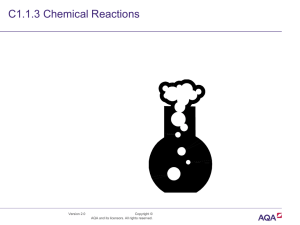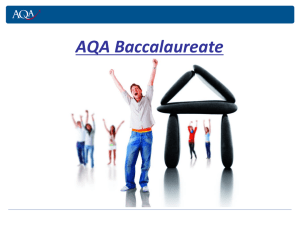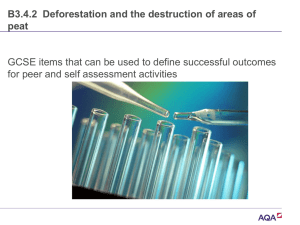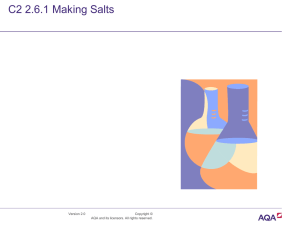Scheme of work
advertisement
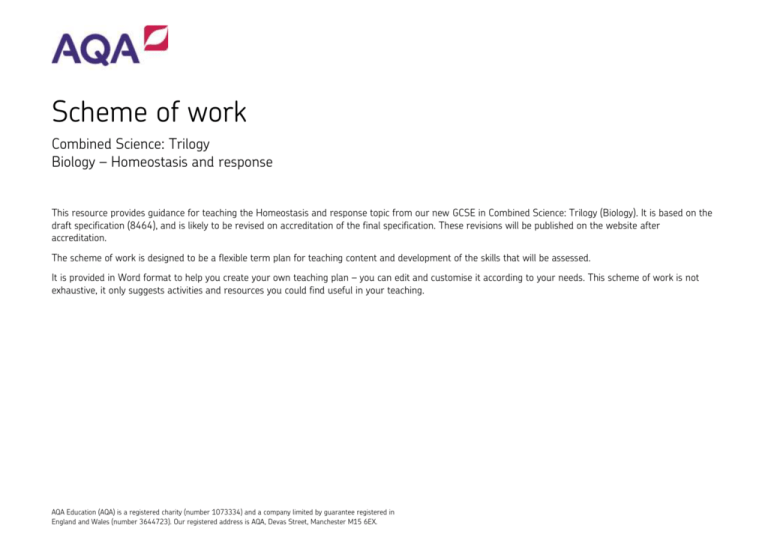
Scheme of work Combined Science: Trilogy Biology – Homeostasis and response This resource provides guidance for teaching the Homeostasis and response topic from our new GCSE in Combined Science: Trilogy (Biology). It is based on the draft specification (8464), and is likely to be revised on accreditation of the final specification. These revisions will be published on the website after accreditation. The scheme of work is designed to be a flexible term plan for teaching content and development of the skills that will be assessed. It is provided in Word format to help you create your own teaching plan – you can edit and customise it according to your needs. This scheme of work is not exhaustive, it only suggests activities and resources you could find useful in your teaching. AQA Education (AQA) is a registered charity (number 1073334) and a company limited by guarantee registered in England and Wales (number 3644723). Our registered address is AQA, Devas Street, Manchester M15 6EX. 4.5.1 Homeostasis Spec ref. Summary of the specification content Learning outcomes What most students should be able to do Suggested timing Opportunities to develop Scientific Communication skills Opportunities to apply practical and enquiry skills (hours) Self/peer assessment Opportunities and resources Reference to past questions that indicate success 4.5.1.1 Introduction to homeostasis Explain what homeostasis is and why it is important. Homeostasis is the regulation of internal conditions to maintain optimal conditions for enzyme action and cell function. Describe examples of conditions that need to be controlled. Automatic control systems involve nervous responses and chemical responses. Describe the roles of the nervous system and the endocrine system in homeostasis. Describe the main components of a control system and their functions. 0.25 Discussion starters: ‘What would happen if…’ eg: ‘you didn’t drink enough water, ate too many sweets.’ Use a model to explain control systems. Q13S.3F.03 Use examples of diseases that can be controlled, eg diabetes, dehydration, gout. Draw a flow diagram to show the main components of a control system and label with the function of each component. Colour code and annotate given diagrams of body with functions related to homeostasis. Control systems have receptors, a coordination centre and effectors. AQA Education (AQA) is a registered charity (number 1073334) and a company limited by guarantee registered in England and Wales (number 3644723). Our registered address is AQA, Devas Street, Manchester M15 6EX. 2 of 16 4.5.2 The human nervous system Mapping areas of the brain and investigating and treating brain disorders is Higher Tier only. Control of body temperature links with enzyme activity in 4.2.2.1 and maintaining water balance in 4.5.3.3. There are many possible practical activities. Select those which are most appropriate. Spec ref. Summary of the specification content Learning outcomes What most students should be able to do Suggested timing (hours) Opportunities to develop Scientific Communication skills Opportunities to apply practical and enquiry skills Self/peer assessment Opportunities and resources Reference to past questions that indicate success 4.5.2.1 Structure and function of the nervous system. Functions: to detect and react to stimuli; to coordinate behaviour. Structure: the CNS is made up of the brain and spinal cord; receptors, different types of neurones, coordinator as brain or spinal cord, effectors, synapses. Required practical 4: investigate the Explain the importance of being able to respond to environmental changes and coordinate behaviour. Explain how the nervous system is adapted for its functions. Describe the functions of the main structures in the nervous system. Explain the role of chemicals at synapses. Describe and use different methods to measure reaction time. Required practical 1 Starter: any short clip that has a ‘surprise’. Explain how detection of stimuli protects the body from danger. Demo: response to different temperatures. Detecting different tastes on the tongue – draw results on diagram of tongue. Plan and manage a variety of stimuli to illustrate body responses. Present and analyse results, eg: Response to temperature. Taste receptors. Skin sensitivity. Investigate sensitivity of different areas of the body. Make a plan to investigate a factor on human reaction time. AQA Education (AQA) is a registered charity (number 1073334) and a company limited by guarantee registered in England and Wales (number 3644723). Our registered address is AQA, Devas Street, Manchester M15 6EX. three bowls of water – hot, warm and icecold salt, sugar, coffee and lemon solutions to taste hairpins, ruler, blindfolds. BBC Bitesize: The nervous system Measure reaction time using different methods, eg Sheep Dash Activity (see resources). Plan for Required practical. Body responses: Reaction time test BBC Sheep reaction time test Evaluate different methods for measuring reaction time. Nervous system Required practical Plan a controlled investigation. 3 of 16 Spec ref. Summary of the specification content Learning outcomes What most students should be able to do Suggested timing (hours) Opportunities to develop Scientific Communication skills Opportunities to apply practical and enquiry skills Self/peer assessment Opportunities and resources Reference to past questions that indicate success effect of a factor on human reaction time. 4.5.2.1 4.5.2.1 Required practical 4: investigate the effect of a factor on human reaction time. Carry out a controlled investigation, present and analyse the results. 1 Reflex actions; The brain Explain the importance of reflex actions and give examples. 1 Reflex actions are automatic and rapid to protect the body from harm. Describe the differences between voluntary and reflex actions. Describe the stages of a reflex action. Required practical write up. Required practical Carry out a controlled investigation, present and analyse the results. Use knee-jerk and pupil reflexes as a stimulus for discussion. Students discuss their importance and gather other examples leading into explanation of why they are faster than a voluntary action. Use a model to describe a reflex action. See Practical Handbook Cards to sequence. BBC Bitesize – The nervous system PPT: B1.2 The nervous system Label a diagram of a reflex arc. Draw a flow diagram or use cards to show the sequence in a reflex action. Use BBC activity (see resources) as a summary of the nervous system. AQA Education (AQA) is a registered charity (number 1073334) and a company limited by guarantee registered in England and Wales (number 3644723). Our registered address is AQA, Devas Street, Manchester M15 6EX. 4 of 16 4.5.3 Hormonal coordination in humans Treatment for diabetes links with 4.1.2.3 Stem cells. Water and nitrogen balance links with 4.1.3.2 Osmosis and 4.1.3.3 Active transport. ADH activity links with section 4.5.3.7 Negative feedback. Spec ref. Summary of the specification content Learning outcomes What most students should be able to do Suggested timing Opportunities to develop Scientific Communication skills Opportunities to apply practical and enquiry skills (hours) Self/peer assessment Opportunities and resources Reference to past questions that indicate success 4.5.3.1 Human endocrine system The system is composed of endocrine glands that secrete hormones into the blood to be carried to a target organ where it has an effect. The positions of the pituitary, thyroid, adrenal glands, ovaries and testes. The pituitary is the master gland. It secretes many hormones that affect other Describe the endocrine system and define the term hormone. Relate hormone release and hormone action to the control system model introduced in 4.5.1.1. Label a diagram of the organs in the endocrine system. Explain why the pituitary gland is often called the master gland. Compare the actions of the nervous and endocrine systems. 0.5 Collective memory or Card sort using hormone name, function and location. Self-assess. Pin the tail on the donkey type activity – give each student a card and get them to stick it on a large body outline, self-assess the end result. Relate hormone release and hormone action to the control system model. QBB04.F.14 Torso and large image of the human body. Q12WY1F08 Label a diagram of the endocrine system using information on the cards Write definitions for endocrine system and hormone. Discuss why the pituitary gland is called the master gland. Compare the actions of the endocrine system with the nervous system. AQA Education (AQA) is a registered charity (number 1073334) and a company limited by guarantee registered in England and Wales (number 3644723). Our registered address is AQA, Devas Street, Manchester M15 6EX. 5 of 16 Spec ref. Summary of the specification content Learning outcomes What most students should be able to do Suggested timing Opportunities to develop Scientific Communication skills Opportunities to apply practical and enquiry skills (hours) Self/peer assessment Opportunities and resources Reference to past questions that indicate success glands. Hormones are chemical messengers. The effects of the endocrine system are slower, but longer acting than the nervous system. 4.5.3.2 Control of blood glucose concentration Describe how blood glucose concentration is monitored and controlled. Blood glucose concentration is monitored and controlled by the pancreas. It produces insulin, which causes glucose from the blood to enter cells. Explain when insulin is produced and how it helps to control blood glucose levels. Glucose is converted to glycogen in liver and muscle cells Describe glycogen as a stored carbohydrate. HT: Explain when glucagon is produced by the pancreas and its effect on blood glucose levels. Explain how insulin and glucagon work together to 1 Class practical – investigating sugar levels in urine. What disease can cause glucose in urine? Research and produce a report to explain the cause, effects, treatment and problems associated with Type 1 diabetes. diabetes.org.uk is a good resource. Interpret data on glucose tolerance tests in healthy people and diabetics. Research the work of Banting and Best. AQA Education (AQA) is a registered charity (number 1073334) and a company limited by guarantee registered in England and Wales (number 3644723). Our registered address is AQA, Devas Street, Manchester M15 6EX. Demo: how doctors used to diagnose diabetes by tasting fake urine, then test with Benedict’s solution and glucose test strips. Evaluate the methods. Demo materials: weak tea samples with and without glucose glucose test strips Benedict’s solution water bath. BBC Bitesize: Homeostasis Insulin and blood sugar control Banting and Best: Diabetes – a cure 6 of 16 Spec ref. Summary of the specification content Learning outcomes What most students should be able to do Suggested timing Opportunities to develop Scientific Communication skills (hours) Opportunities to apply practical and enquiry skills Self/peer assessment Opportunities and resources Reference to past questions that indicate success for storage. 4.5.3.2 HT: Glucagon is also produced by the pancreas to convert stored glycogen back into glucose when blood glucose levels fall. In Type 1 diabetes the pancreas does not produce enough insulin. Glucose levels may rise too high. control blood glucose levels. Explain the cause, effects, treatment and problems associated with Type 1 diabetes. Interpret glucose tolerance test results. Evaluate modern methods of treating diabetes. Type 2 diabetes is usually treated by diet, exercise and drugs. Obesity is a ‘Explaining diabetes’ animation Research how treatment of diabetes has developed including use of human insulin produced by bacteria, current research into pancreas cell transplants and stem cell research (links with 4.1.2.3). Q10WY2H03 Discuss the causes, treatment and problems associated with Type 2 diabetes. Compare Type 1 and Type 2 diabetes and present the information in a suitable format. Type 1 diabetes is usually treated with insulin injections. In Type 2 diabetes the cells do not respond properly to insulin. Watch video clip about Banting and Best. Watch a video animation about Type 1 and Type 2 diabetes. Explain the cause, treatment and problems associated with Type 2 diabetes. Compare the causes, and treatments of Type 1 and Type 2 diabetes. AQA Education (AQA) is a registered charity (number 1073334) and a company limited by guarantee registered in England and Wales (number 3644723). Our registered address is AQA, Devas Street, Manchester M15 6EX. 7 of 16 Spec ref. Summary of the specification content Learning outcomes What most students should be able to do Suggested timing Opportunities to develop Scientific Communication skills Opportunities to apply practical and enquiry skills (hours) Self/peer assessment Opportunities and resources Reference to past questions that indicate success risk factor for Type 2 diabetes. 4.5.3.3 Water and nitrogen balance Water leaves the body via the lungs during exhalation. Water, ions and urea are lost from the skin in sweat. There is no control over water, ion or urea loss by the lungs or skin. Excess water, ions and urea are removed via the kidneys in the urine. If body cells lose or gain too much water by osmosis they do not function efficiently. Describe where water, ions and urea are lost from the body. 0.5 Label a diagram. Link each organ to the condition it helps to control in the body. Explain why there is no control over water, ion and urea loss by the lungs and skin. Starter: micrograph images animal cell in normal, concentrated salt and pure water – what caused the changes? Explain when cells might gain or lose too much water, in terms of osmosis (links with 4.1.3.2). Urine colour chart – how could the colour change depending on the time of year etc? Describe the effect of too much or too little water on cells. Use past exam questions on Exampro to balance water loss. Draw animal cells exposed to saline, dilute and concentrated salt solutions. Explain the observations. Demo materials: prepared slides and microscopes bio-viewers or micrographs of animal cells in saline, dilute and concentrated salt solutions. Nutrition and hydration Q12SY2F03 Explain how the body responds to different temperature and osmotic challenges in terms of sweat and urine release. AQA Education (AQA) is a registered charity (number 1073334) and a company limited by guarantee registered in England and Wales (number 3644723). Our registered address is AQA, Devas Street, Manchester M15 6EX. 8 of 16 Spec ref. Summary of the specification content Learning outcomes What most students should be able to do Suggested timing Opportunities to develop Scientific Communication skills Opportunities to apply practical and enquiry skills (hours) Self/peer assessment Opportunities and resources Reference to past questions that indicate success 4.5.3.3 4.5.3.3 HT: urea is produced in the liver by the breakdown of excess amino acids. Kidney function The kidneys produce urine by filtration of the blood and selective reabsorption of useful substances. All the sugar and dissolved ions needed by the body and as much water as the body needs are selectively reabsorbed. Urea, excess ions and water are excreted in urine. HT: Draw a flow diagram to explain how urea is formed. HT: Describe how amino acids are deaminated in the liver to form ammonia, which is converted to urea for excretion. Label a diagram of the excretory system. Describe how urine is produced. Describe the absorption of glucose and ions by diffusion and active transport. 1 Locate the positions of the liver, kidneys and bladder in the human. Explain the need to excrete urea. Label a diagram of the excretory system. Observe the structure of a kidney. Use cards to sequence how urine is made and produce a flow diagram. Name the useful substances reabsorbed by the body and relate to diffusion and active transport. Use a model torso. Torso Use a model kidney. Model kidney Dissection of pig’s kidney. Use cocktail sticks and stickers to make ‘flags’ for the key features and photograph the labelled kidney to stick in books. Dissection: pig’s kidneys scalpel scissors dissection board gloves. BBC Bitesize: Excretion in plants and animals Q11WY3H07 AQA Education (AQA) is a registered charity (number 1073334) and a company limited by guarantee registered in England and Wales (number 3644723). Our registered address is AQA, Devas Street, Manchester M15 6EX. 9 of 16 Spec ref. Summary of the specification content Learning outcomes What most students should be able to do Suggested timing Opportunities to develop Scientific Communication skills Opportunities to apply practical and enquiry skills (hours) Self/peer assessment Opportunities and resources Reference to past questions that indicate success 4.5.3.3 ADH HT: ADH is released by the pituitary gland when the blood is too concentrated. It causes more water to be reabsorbed back into the blood. ADH control of water in the blood is an example of negative feedback. 4.5.3.3 Kidney failure Kidney failure can be treated by kidney transplant or by using kidney dialysis. 4.5.3.3 How a dialysis machine works. HT: Identify the site of production and target organs for ADH. 0.5 Describe the effects of ADH on kidney tubules. Explain, with the aid of a diagram, how ADH controls the concentration of the blood using a negative feedback mechanism (links with 4.5.3.7). Use a diagram or torso to describe the site of production and target organs for ADH. Model of human body to identify organs. Describe the effect of ADH on the kidney tubules and relate to volume of urine produced if you are thirsty. Predict whether ADH secretion and volume of urine is high or low for different situations, eg person running on hot day. Torso Kidneys and water balance Use the ABPI activities (see resources) to explain the negative feedback mechanism involved in control of water concentration in the blood. Draw a diagram to explain ADH negative feedback mechanism. Describe the advantages and disadvantages of a kidney transplant. 2 Discuss why a kidney transplant is not available for everyone. Discuss the advantages and disadvantages of a transplant. Design a poster to explain and encourage people to carry organ donor cards. Explain how a kidney machine works. Use ABPI resources on dialysis and kidney transplants. Explain why dialysis fluid contains sugar and ions at the same concentration as Discuss the advantages and disadvantages of dialysis AQA Education (AQA) is a registered charity (number 1073334) and a company limited by guarantee registered in England and Wales (number 3644723). Our registered address is AQA, Devas Street, Manchester M15 6EX. Set up a model for dialysis using cellulose tubing. Test for glucose, salt and protein. Dialysis: cellulose tubing pipettes fake urine boiling tubes test tubes Benedict’s solution or glucose test sticks biuret reagent or albustix 10 of 16 Spec ref. Summary of the specification content Learning outcomes What most students should be able to do Suggested timing Opportunities to develop Scientific Communication skills Opportunities to apply practical and enquiry skills (hours) Self/peer assessment Opportunities and resources Reference to past questions that indicate success normal blood, but no urea. 4.5.3.3 Evaluate the use of kidney transplants and dialysis to treat kidney failure. treatment. Research how a dialysis machine works and produce a script for a new nurse in the dialysis clinic to explain the procedure. Explain the results for the model dialysis machine (links with 4.1.3.1). Label a diagram of a kidney dialysis machine and add notes to explain the constituents of the fluid and how the machine restores the concentration of dissolved substances in the blood to normal. Discuss a moral dilemma – research cost of dialysis and transplants. Discuss considerations in terms of cost as to how kidney patients should be treated – lifetime dialysis, transplant, shortage of kidneys, buying kidneys from healthy people and prioritising lists for surgery. Produce arguments for and against the options. AQA Education (AQA) is a registered charity (number 1073334) and a company limited by guarantee registered in England and Wales (number 3644723). Our registered address is AQA, Devas Street, Manchester M15 6EX. Describe the economic, ethical and medical considerations regarding treatment of kidney failure and evaluate the choice of treatments for kidney failure. Analyse urine samples and identify who each one came from. Give reasons for the conclusions. nitric acid and silver nitrate solution dialysis fluid water goggles. What is dialysis? Urine: artificial urine samples made with tea – sugar added, protein added, normal colour, dilute, concentrated biuret reagent or albustix Benedict’s solution or glucose test sticks test tubes water bath goggles. 11 of 16 Spec ref. Summary of the specification content Learning outcomes What most students should be able to do Suggested timing Opportunities to develop Scientific Communication skills (hours) Opportunities to apply practical and enquiry skills Self/peer assessment Opportunities and resources Reference to past questions that indicate success Identify urine samples from a healthy person, diabetic, person with kidney failure, healthy person who had drink a lot and person who had been doing hard work in hot weather. 4.5.3.4 Hormones in human reproduction Describe secondary sexual characteristics of boys and girls. During puberty hormones cause sexual characteristics to develop. Explain the cause of these changes in boys and girls and their relevance in reproduction. In females oestrogen is produced by the ovaries. Eggs mature and are released (ovulation) every 28 days. In males testosterone is produced by the testes and stimulates sperm Describe the menstrual cycle and fertility including the role of hormones. Oestrogen is secreted by the ovaries. It inhibits production of FSH and stimulates release of LH. It makes the uterus lining grow again after menstruation. Progesterone is secreted by the empty follicle in the ovary after ovulation. It inhibits FSH and LH production and maintains the lining of the 1 Watch BBC video clip about puberty. BBC Bitesize: Puberty Describe the changes that occur in boys and girls during puberty and discuss what causes these changes. BBC Bitesize: Ovulation Watch BBC video clips of ovulation and the menstrual cycle. Discuss how hormones control the changes seen. BBC Bitesize: Menstrual cycle PPT B1.2.2 Control in the human body Use a month calendar page to colour code days according to hormone levels (make a flickbook to show changes) Use a model, eg diagram, chart, animation etc to show the names, sites of production and effects of FSH, LH, oestrogen and progesterone in the menstrual cycle. HT will require AQA Education (AQA) is a registered charity (number 1073334) and a company limited by guarantee registered in England and Wales (number 3644723). Our registered address is AQA, Devas Street, Manchester M15 6EX. 12 of 16 Spec ref. Summary of the specification content Learning outcomes What most students should be able to do Suggested timing Opportunities to develop Scientific Communication skills Opportunities to apply practical and enquiry skills (hours) Self/peer assessment Opportunities and resources Reference to past questions that indicate success production. The roles of FSH, LH, oestrogen and progesterone in the menstrual cycle of a woman. 4.5.3.4 HT: more detail is required for the roles of these hormones. 4.5.3.5 Contraception Fertility can be controlled using hormonal and non-hormonal contraceptives. 4.5.3.5 Eg hormonal: uterus during the second half of the cycle. HT: explain the interaction between these hormones in the control of the menstrual cycle. Describe hormonal and nonhormonal methods of contraception. Explain how hormonal and non-hormonal contraceptives work. Evaluate their use. oral contraceptives injection implant or skin patch. Eg non-hormonal: barrier methods IUDs more detail. Evaluate their use. 1 Watch BBC video clip about history of contraception for women (contains distressing scene). Discuss issues raised. Look at an exhibition of hormonal and non-hormonal contraceptives. Complete a table summarising: method of action, hormone name, how they work, advantages, disadvantages. Consider personal, social, economic and ethical implications of contraceptive use. Study contraceptives in an exhibition and evaluate the different types. BBC Bitesize: Development of the contraceptive pill Exhibition materials can be obtained from the Family Planning Association. Produce a report for a teen magazine on the advantages and disadvantages of different types of contraceptives. Invite an outside speaker to discuss contraception, eg AQA Education (AQA) is a registered charity (number 1073334) and a company limited by guarantee registered in England and Wales (number 3644723). Our registered address is AQA, Devas Street, Manchester M15 6EX. 13 of 16 Spec ref. Summary of the specification content Learning outcomes What most students should be able to do Suggested timing Opportunities to develop Scientific Communication skills Opportunities to apply practical and enquiry skills (hours) Self/peer assessment Opportunities and resources Reference to past questions that indicate success spermicides abstinence sterilisation surgery. 4.5.3.6 women’s health nurse. Describe the use of fertility drugs in women with low FSH levels. Women can be given a ‘fertility drug’ containing FSH and LH to stimulate ovulation. Use a model, eg a flow diagram to explain the process of In Vitro Fertilisation (IVF). Research the process of IVF and produce a leaflet for a doctor’s surgery to describe the main stages involved in IVF treatment. Evaluate the use of fertility treatments. UPD8 activity about womb transplants. In IVF treatment FSH and LH are given to stimulate many eggs to mature. These are collected and fertilised by sperm in a lab. Embryos form, and some are inserted into the woman’s uterus. 1 Discuss possible causes of infertility in men and women and treatments available. HT: The use of hormones to treat infertility. Discuss the implications of IVF treatment for a couple wanting a baby. AQA Education (AQA) is a registered charity (number 1073334) and a company limited by guarantee registered in England and Wales (number 3644723). Our registered address is AQA, Devas Street, Manchester M15 6EX. UPD8 – apply different ethical approaches to making a decision about non-vital transplants. UPD8 – Womb transplant 14 of 16 Spec ref. Summary of the specification content Learning outcomes What most students should be able to do Suggested timing Opportunities to develop Scientific Communication skills Opportunities to apply practical and enquiry skills (hours) Self/peer assessment Opportunities and resources Reference to past questions that indicate success 4.5.3.6 The advantages and disadvantages of fertility treatment, eg stress, success rate and multiple births. 4.5.3.7 HT: Negative feedback. Adrenaline is produced by the adrenal glands in times of stress. It increases heart rate so oxygen and glucose are supplied to the brain and muscles faster. Thyroxine is produced by the thyroid gland. It stimulates BMR and plays an important role in physical and mental Describe where and when adrenaline is released and its target organs. Describe the effects of adrenaline on the body. Draw a diagram to explain how levels of adrenaline are controlled by a negative feedback system. Describe where thyroxine is produced and its effects on the body. Draw a diagram to explain how its release is stimulated by thyroid stimulating hormone and the levels of these two hormones are controlled by a negative feedback system. 0.5 Use a model to show where adrenaline and thyroxine are produced, and their target organs. Identify organs on a model. ABPI – Adrenaline and ADH You & Your Hormones – Adrenaline Research the effects of the two hormones on the body and present the findings in a suitable format. Include diagrams to illustrate negative feedback mechanisms for each hormone. Use ABPI site and internet. Investigate the effect of stress, and removal of stress, on heart rate. AQA Education (AQA) is a registered charity (number 1073334) and a company limited by guarantee registered in England and Wales (number 3644723). Our registered address is AQA, Devas Street, Manchester M15 6EX. Torso Measure heart rate and/ or blood pressure as indicators of stress. Relate the changes to adrenaline secretion. Stress 15 of 16 Spec ref. Summary of the specification content Learning outcomes What most students should be able to do Suggested timing Opportunities to develop Scientific Communication skills (hours) Opportunities to apply practical and enquiry skills Self/peer assessment Opportunities and resources Reference to past questions that indicate success development. Adrenaline and thyroxine secretions are controlled by negative feedback mechanisms. AQA Education (AQA) is a registered charity (number 1073334) and a company limited by guarantee registered in England and Wales (number 3644723). Our registered address is AQA, Devas Street, Manchester M15 6EX. 16 of 16

